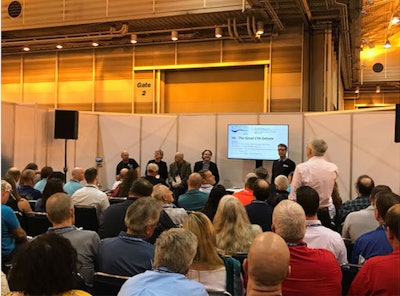
I watched AQUA’s CYA forum at the PSP Expo in New Orleans, “the Great CYA Debate,” trying to filter out some practical advice for people servicing pools. Taking the pieces of guidelines that the panelists agreed on and making sense of it goes this way. They agreed to a free chlorine level that is 20:1 and 4.0 ppm max as allowed by FIFRA (the Federal Insecticide, Fungicide, and Rodenticide Act is a United States federal law that sets up the basic U.S. system of regulation for sanitizers).
We know that 20:1 is 5%, so if free chlorine is held to a maximum of 4.0 ppm, CYA should be allowed up to a maximum of 80 ppm. Therefore the panelists agreed to a maximum CYA of 80 ppm and a corresponding free chlorine of 5% of CYA up to 80 ppm.
Keeping that 20:1 (5%) ratio, then, exceeding 4.0 ppm free chlorine would mean a corresponding CYA of more than 80 ppm. Or exceeding more than 80 ppm CYA would require a corresponding free chlorine of more than 4.0 ppm.
I heard a few times that we cannot exceed the FIFRA maximum of 4.0 ppm free chlorine. But I heard no one mention the EPA maximum of 100 ppm CYA. They seemed very concerned about one maximum but not the other.
On The Trouble Free Pools website, Ben Powell, Richard Falk and I have been telling tens of thousands of residential pool owners and residential service technicians since 2007 that the free chlorine level needs to be 7.5% of the CYA level unless borate at 50 ppm is being used in which case, the level needs to be 5% of CYA. Of course, we have been talking about residential pools, not commercial or public pools.
RELATED: New Thinking — Chlorine/CYA in Balance
But high levels of CYA cause problems other than decreased kill rate for pathogenic organisms. High CYA levels cause corrosive water because of the adjustment needed to obtain carbonate alkalinity used in the calculation of the Saturation Index.
Most of us know that in the calculation of the SI, one must take a portion of the CYA level away from the total alkalinity level. The percentage of the CYA that must be subtracted is dependent upon the pH of the water. At a pH of 7.2, it is 27%, at a pH of 7.5 it is 32%, and at a pH of 7.8, it is 35%. So if you have a CYA level of 100 ppm, you multiply 0.32 × 100 and get 32 ppm. Now you subtract 32 ppm from the total alkalinity and use that number when finding the total alkalinity factor in the tables. If the TA is 120 ppm, you subtract 32 ppm and get 88 ppm. Now you lookup the factor for 88 ppm for TA. The 88 ppm is the carbonate alkalinity.
Many pools that have been using trichlor tabs for a long time may have CYA levels of 200 ppm or 300 ppm and I have even seen some at 400 ppm and more. When you take 32% of 300 ppm CYA which is 96 ppm and subtract that from a TA of 120 pp, the carbonate alkalinity is 24 ppm. This makes for very corrosive water which can dissolve metals and etch plaster. Dissolved metals can lead to staining when the saturation point of the dissolved metals in the water is exceeded. These conditions are not good for the vessel, the plumbing or the equipment.
We also see pools getting algae a couple of months into the swimming season. Sometimes it is the fault of the CYA. Most health agencies such as CDC and WHO agree that it takes 0.01 to 0.05 ppm HOCl to kill algae. And we know that at 30 ppm CYA there is only 3% of the chlorine in the water that is not bound to CYA. Of the 3%, about 50% is HOCl and 50% OCl–. HOCl is the killing form of chlorine. OCl– is inactive. To calculate if there is enough HOCl in the water at 2.0 ppm free chlorine, we multiply 2.0 ppm FC by 0.15 and get 0.03 ppm HOCl — this is not enough free chlorine to kill algae. But rather than do this math, it is easier to know the free chlorine amount should be 5% of CYA.
RELATED: Experts Share Their Take on CYA
So the scenario goes like this. At the beginning of summer, there is 30 ppm CYA and we shock and maintain 2-4 ppm free chlorine. And 0.05 times 30 ppm CYA is 1.5 ppm so there is sufficient FC to kill algae. But if trichlor is being used, the CYA is increasing at about 6 ppm per week or 25 ppm per month. After a month, we now have 55 ppm CYA and 5% is 2.75 ppm free chlorine. If there is 2.75 ppm FC or more, algae are killed. In another month, we have 25 ppm more CYA for a total of 80 ppm CYA. So 5% of 80 ppm is 4.0 ppm free chlorine needed. If the FC in the water is less than 4.0 ppm, we can begin to see algae start growing. And in another month we have 105 ppm CYA which requires 5% or 5.25 ppm free chlorine. Now we probably have algae because we are not keeping FC at 5% of CYA. Pools are keeping a constant FC or just anywhere between 2.0 and 4.0 ppm and this may not be enough depending on CYA levels.
I have also seen pools that have been drained and refilled which gives a zero CYA reading but a week later have 30 ppm CYA. That means the CYA was in the plaster, plumbing or filter and is re-dissolved into the water. That cannot be good.
So CYA is good, but too much can have problems.







































